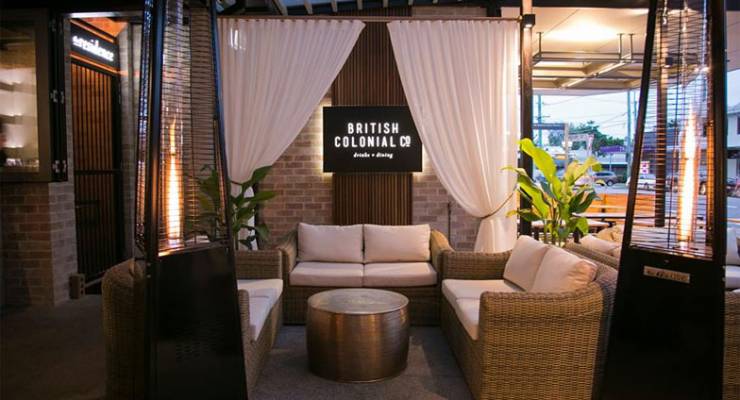
You’re never going to believe this, but, apparently, there were those expressing outrage on the internet yesterday. And, as if that act were not unprecedented enough, then news organisations took this moment of dissatisfaction and used it for one hundred opinion pieces. A mild moment of social media outrage turned into a day of pronouncements by a dying traditional media too under-funded and incompetent to report on anything real? Yes! What could be next. Horseless carriages, probably. Driverless ones.
Look. If you want, you can read one of the dozens of pieces that tell the “story” of a restaurant with an insensitive menu being trolled on Facebook. You can even try to knock some meaning out of what was, in my view, a few dozen people making some quick jokes about Brisbane joint British Colonial Co, whose website celebrated the “empirical push” into “the developing cultures of the world”. Some people, not unjustifiably, told proprietors of the restaurant that such blithe marketing was not on, particular in a city with a large indigenous population still living the aftershock of that “push”. Not many, but enough that, you can bet, News Corp will have a story on Political Correctness Gone Mad by morning tea time and The Guardian will have one on the racial insensitivity of News Corp by lunch.
For mine, this is a reasonable case of potential consumers expressing their distaste. The “market” has voted and decided that British Colonial Co should have secured some better branding advice before popping its pith helmet on. It’s not as though there are not competent firms in the very specific business of brand development for the food trade, and I’m sure when Neil Perry opens one of his Asian-themed restaurants aimed, as British Colonial Co is, at a high-end liberal market, he is careful to consult his way out of orientalism. You’re not going to see overt reference to the victims of the Cultural Revolution at Spice Temple, and that it didn’t occur to anyone at this diner in a city still full of the worst evidence of colonialism to obtain professional advice is a commercial misstep.
That’s what it is: bad business. You can take the view, of course, that people are just too damn sensitive these days and have no real battles to fight other than those that take place on Facebook. And you might even have a bit of a case. But the fact is, opening a restaurant is rarely cheap, always risky and if you’re going for a post-historic “playful” theme, you better make sure, for the sake of your ledger, that you get it right. Because many restaurants do.
Back in the days of print, I was an occasional contributor to The Age’s once very good food insert, Epicure. I visited and read about many higher-end restaurants that had, in many cases, begun to perform an “edgy” aesthetic to get the posher punters in. I remember that Guy Grossi had quite a successful venture in St Kilda that playfully served what he, an Italian Australian, called “continental” food. Grossi served things like chocolate mousse and chateaubriand beneath pictures by Mirka Mora, the Melbourne celebrity artist who came to define European chic for many Skippy suburbanites in the 1960s. It was a cute way to redefine what was — let’s face it — unapologetic comfort food and Guy, a man who knows his branding as fully as he knows the details of the city’s best grass-fed beef suppliers, did well with this wink to the naive past.
On a NYC eating trip, I went to Traif, a reference to the Yiddish word that means the opposite of kosher. Opened by Jewish proprietors in the still Hassidic neighbourhood of Williamsburg, this place, still in business, served meat with cheese, leavened bread on holy days and, of course, pork. Nearly all of Heston Blumenthal’s wildly successful restaurants play with their food in a similar way, with “food memories” of an idealised British fish’n’chip childhood being dunked in a nitrogen bath. Once at the restaurant of lauded Sydney chef Christine Manfield, I ate a dessert based on the Golden Gaytime. It was a marvellous appropriation of a poor person’s treat, and I think it cost about 30 bucks.
Diners have a sense of humour. I mean, they have to, paying that sort of money for an ice cream. They are prepared to laugh along with restaurateurs, and there are places, like Blumenthal’s Fat Duck, where we pop on a pair of headphones and listen to sounds to enhance our “food memory”. It’s not enough, when one is paying upwards of $40 for a main, just to have a nice steak anymore. We expect a totalising brand experience.
And, yes, of course, I know this is all ridiculous evidence of a leisure class so overstuffed with white truffles, it needs more, more, more. Elite foods are no longer sufficient to tickle us; our collective unconscious must be addressed along with our more natural appetites. But, right or wrong, that’s the high-end food market of the current era. And, if you want to play the playful game, you’d better get it right.
It does occur to me, though, that people have begun to have a gutful of this ahistorical playfulness. In an age of cultural collision — music refers to the past, visual art refers to itself, hipsters refer to anything in history they fancy — there may be some hunger for meaning. Which is to say, perhaps we have gorged ourselves sick on “experiences” — such as this black poverty-themed resort in South Africa — and we want a more stable connection between the aesthetic and the real.
It also occurs to me that British colonial food, like kedgeree or Singapore noodles, is, like a lot of “melting pot” cuisine, especially delicious. So what a shame for the chefs and my stomach that these inauthentic dishes were served up with a side of some very dumb marketing.








Helen, if they really did say it, wouldn’t it be more of a concern that they bragged about their “empirical push” into food of developing cultures? Are we witnessing the birth of evidence-based cuisine?
That’s very funny, Paul.
They probably think that histrionic has something to do with history.